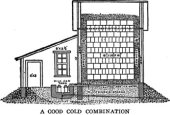While I like the idea of the water tanks, the repeated freeze/thaw might not be ideal. You'd easily burst the pipes eventually.
You might not even need water tanks to keep the area cooler in the summer.
Properly built and insulated, a root cellar would remain cool and ambient all year round, even in the summer, as long as you leave the door closed.
By introducing the tanks, and ice blocks, your not making a cellar, your making an underground freezer, and it's entirely different, especially with moisture.
Ideally, around here, 5ish Newfoundland, cellars aren't dug out of hillsides unless needed because of space, that interrupts the local ground water drainage, etc and introduces the risk of to much moisture. The old timers would simply pick a spot with drainage, or between hills and large rocks, most were simply built directly ontop of undisturbed soil in a spot in the garden where nothing would grow(usually over a scath of rock). They'd make a box room in general, with a strong roof, then pile stone and sod, building it up, all around the box, then heaping it over to make a thick natural roof. Then as they eventually cleaned out more rocks from the gardens over time, they'd end up thrown and heaped around the cellar and it'd become it's own hill. They only fell out of favour when, because of the WW2, most of the men who did the maintenance were laboured off or went to war. Without maintenance, they easily became susceptible to rats who dug out the sod, and inbetween the rocks(at least that's what happened local to me and my family), then the returning men brought with them electricity and proper refrigeration units(yes, most rural villages around here didn't get power or town running water until the 60's, or later).
In the last half of the 1900's, basements were regarded as cellars and treated as such. A shed, workshop or even a house was built over top with as good an insulated floor/ceiling they could arrange for, and things like the boiler, was kept at ground level, most people didn't have furnaces but still use wood stoves.
They're a lot like mini-Hobbit holes. Hobbit homes were initially inspired and described as actually being root-cellars. Much of the same technology and building aspects of a hobbit-house would apply to root-cellars.
They're generally out of favour because root-cellars aren't exactly tidy little things that most people expect. A decent sized root-cellar has a ground foot-print nearly the same size of the tiny salt-box houses, most that I've seen in person have a ground foot print the size of a single-car garage, and people simply don't have the space. These styles of root-cellars were used all year round, generally kept dry, and kept things like milk, butter and cheese cool enough during summer days that they didn't spoil(generally because a family would go thru it before that happened, but they were used to store daily meals).
But, I have to admit, that most of these same places are built on the ocean, and everyone has a stage head on a wharf in general that had a fish box(a plastic insulated double-walled ice box about the size of a hot tub since about the 70's, before then, a wooden chest with a metal pan with a drain that would run out) that they'd stuff with ice, either cut out of the ocean during the winter, or refilled during the summer with ice from ice-burgs.
If your settled on having ice as a cooling source, you should consider instead getting a double-wall plastic container, filling it half full of iceblocks during the winter, or frozen bottles or buckets of water, then piling good sawdust ontop and around, then putting a board over it, for storing the things you want really chilled on top. But, even if you keep it cool, to much moisture will rot most veg eventually, and keep in mind that you'll want to be able to drain the thing at some point. As long as this container is kept out of the sun, in a room without a window and the doors closed, and the lid kept locked down unless your using it, this should keep the ice mostly frozen. Do you have any hope of keeping food frozen in there? Nope, it won't freeze things, and it won't keep 'real' ice cream frozen(most of the commercial stuff these days is made of some kind of cream/froth and isn't actually real milk just google for unmeltable ice cream bars). But it will delay thaw out, and it will keep unopened milk longer than a fridge does, in general.
Some links with a lot of pictures of local root cellars, old and modern.
http://www.townofelliston.ca/2at/rootcellars.html#cellar
http://doodledaddle.blogspot.ca/search/label/root%20cellars
http://collections.mun.ca/cdm/search/collection/ich_nature/searchterm/Root%20Cellar%20Traditions/field/subcol/mode/all/conn/and/cosuppress/


































